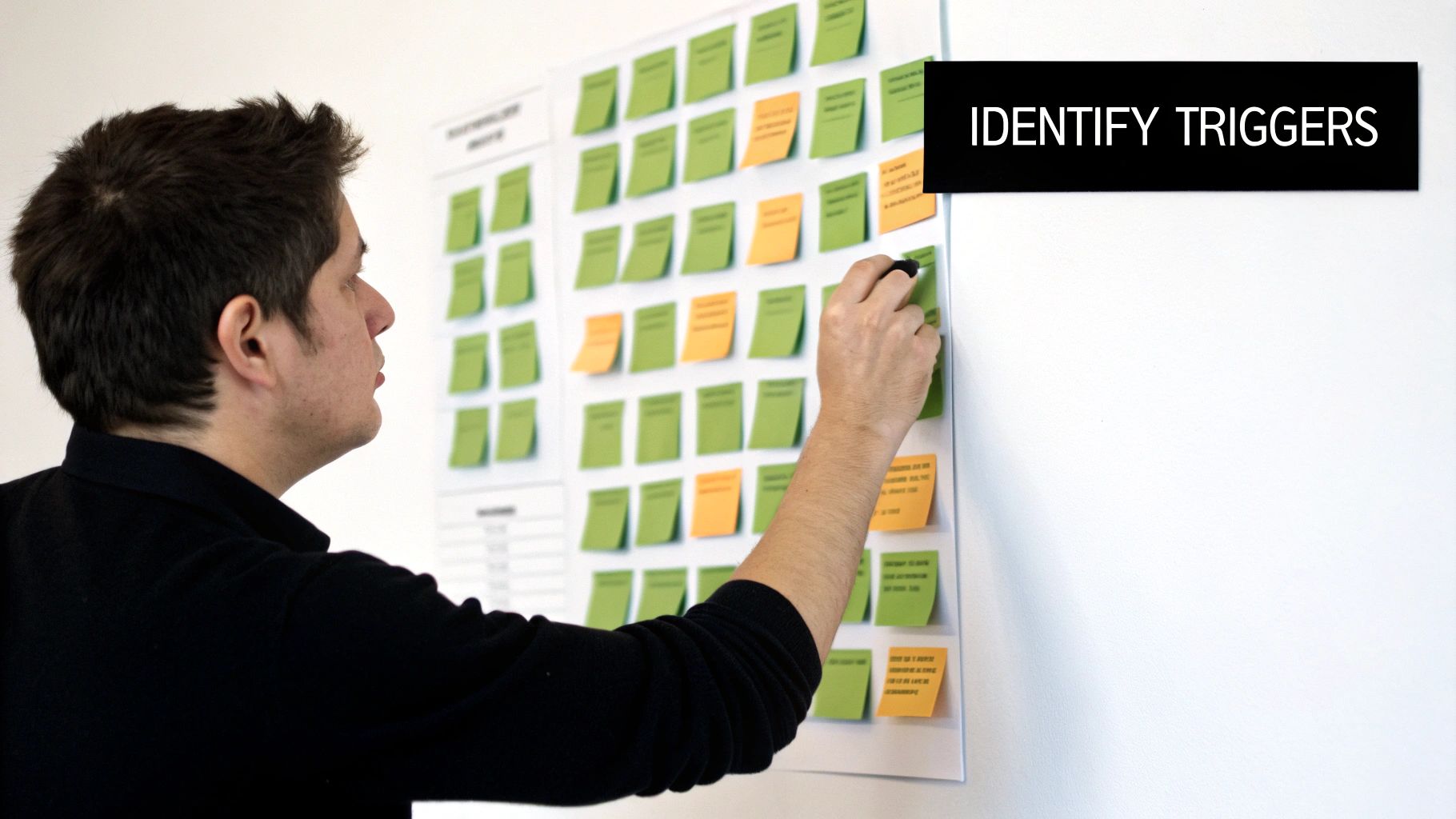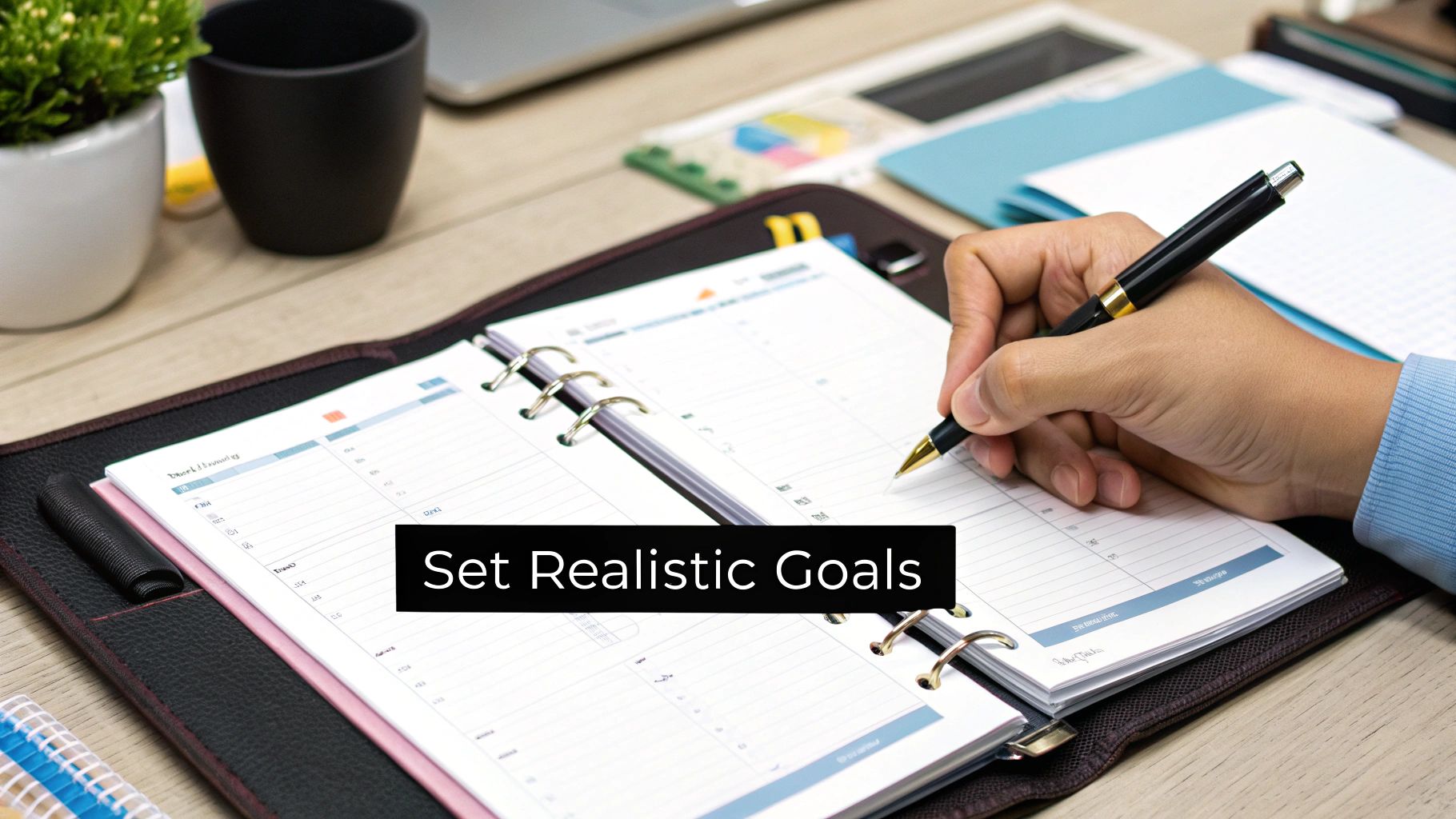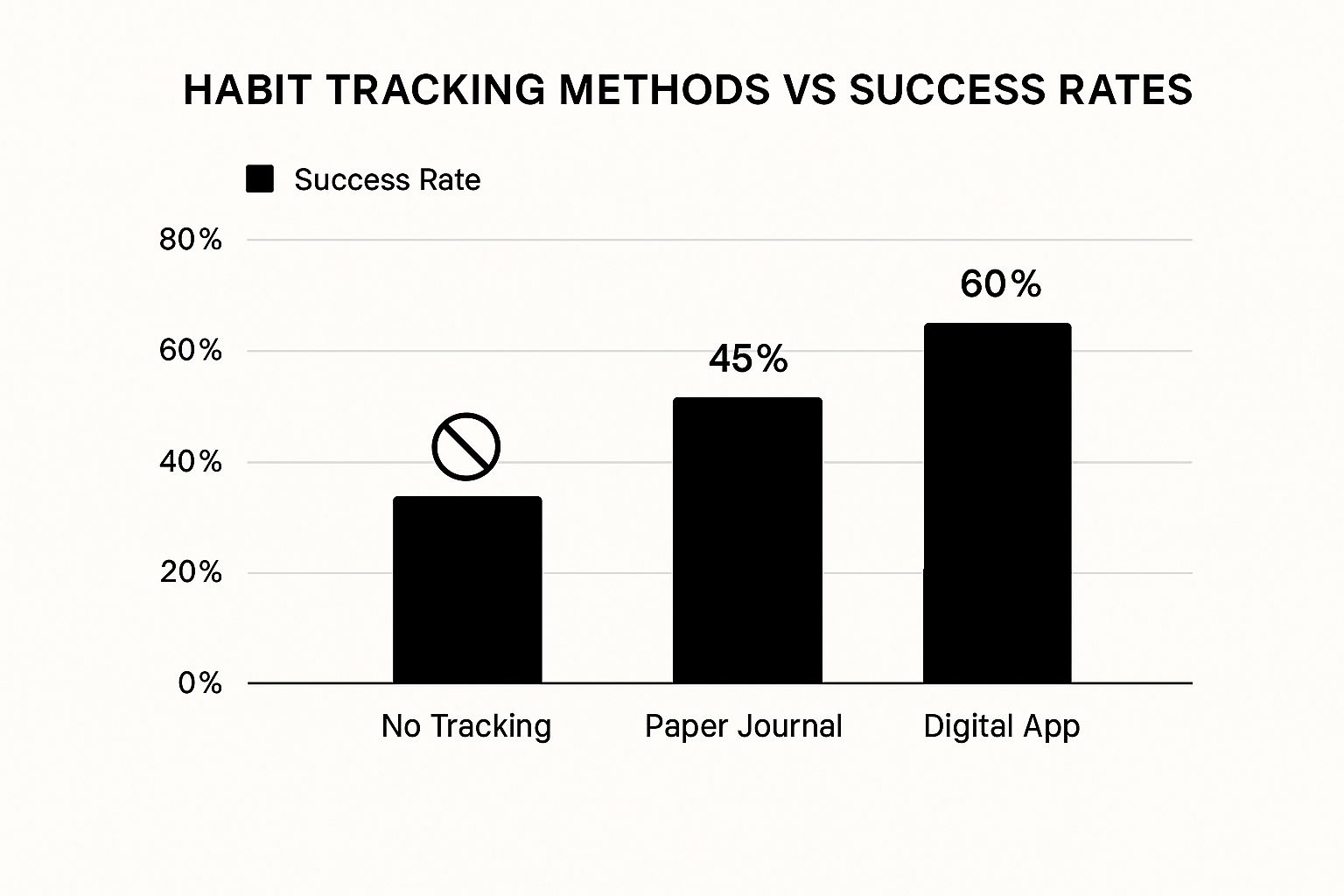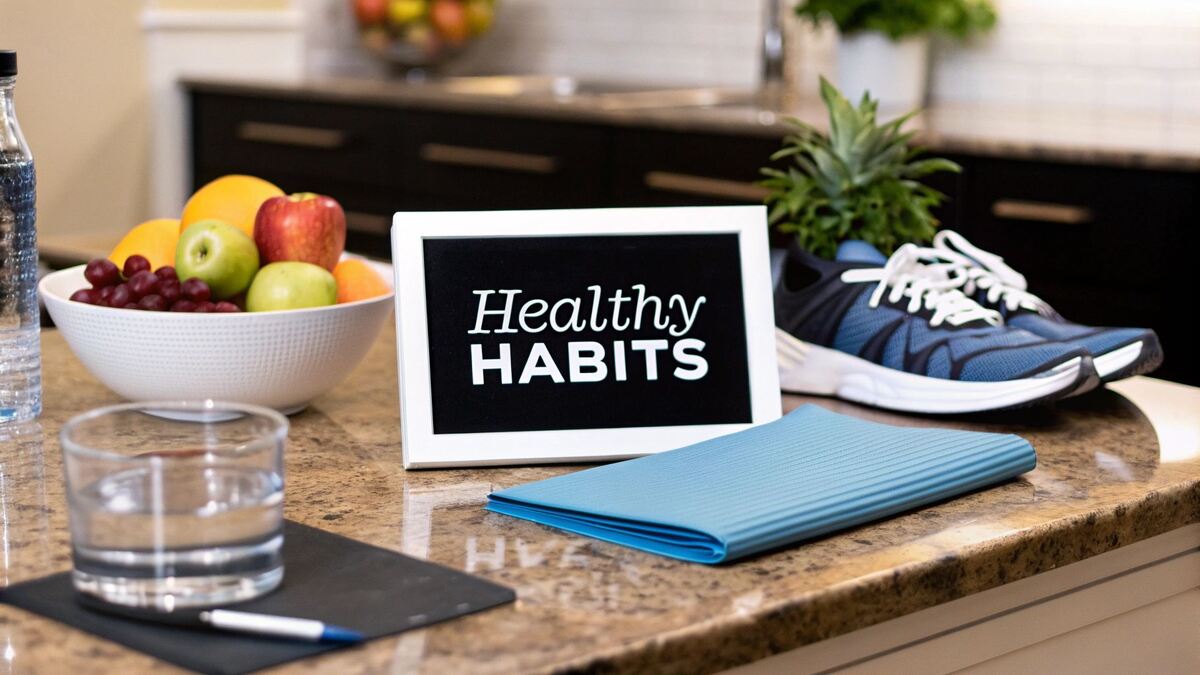How to Build Healthy Habits That Actually Stick
It's a familiar story, isn't it? You make a bold resolution, full of motivation, only to see it completely fall apart by February. We often point the finger at a lack of willpower, but the real problem usually lies in the strategy—or lack thereof.
Sustainable change isn’t about making massive, life-altering shifts overnight. It's about understanding the quiet, powerful systems that run our daily lives on autopilot.
Why Most New Habits Fail Before They Start
Let’s get real for a moment. Most attempts to build healthy habits are doomed from the start because they rely on sheer force of will. But willpower is a lot like a muscle; it gets tired. When a stressful day at work hits or life throws you a curveball, that muscle is the first thing to give out.
That's why a sudden, drastic decision to completely overhaul your diet and hit the gym six days a week usually ends in burnout and a return to old, comfortable patterns.
The Science of the Habit Loop
Every single one of your habits—good, bad, or neutral—is driven by a simple neurological cycle. Scientists call it the "habit loop," and it has three key parts:
- The Cue: This is the trigger. It’s the spark that tells your brain to kick into gear. It might be a specific time (like your 3 PM energy slump), a place (walking into the kitchen), or even an emotion (feeling bored or stressed).
- The Routine: This is the action you take, the habit itself. It could be grabbing a cookie, opening up Instagram, or lacing up your running shoes.
- The Reward: This is the payoff. It's the little hit of satisfaction that tells your brain, "Hey, that felt good. Let's remember to do that again."
Trying to change a habit without accounting for this entire loop is like trying to fix a leaky pipe by just mopping the floor. You're not addressing the root cause. Your brain is wired to follow the easiest path to a familiar reward, and fighting that instinct head-on is exhausting.
The secret isn't to fight the loop but to hijack it. You can keep the same cue and deliver a similar reward, but consciously swap in a better routine. This is how you systematically rewire your brain for success.
A major roadblock for many is simple procrastination; figuring out how to stop procrastinating at work and in life can be a game-changer for building momentum. That initial inertia is a powerful force, but it's not invincible.
It's also crucial to be patient. Forging these new neural pathways doesn't happen overnight. Research has shown it takes an average of 66 days for a new behavior to feel automatic. For some, it might be just 18 days; for others, it could be as long as 254 days.
This isn't meant to be discouraging—it's empowering! Knowing this transforms your mindset from a frantic sprint into a steady, long-term marathon. Consistency, not intensity, is what truly builds a habit that lasts.
Design Your Environment for Effortless Wins
Let's be honest: willpower is a fickle friend. Some days you feel like you can conquer the world, but on a tough, stressful day, it's the first thing to vanish. This is why relying on sheer motivation to build healthy habits is a recipe for failure. The real secret is to make good choices the easiest choices.
This idea is sometimes called choice architecture. It's all about setting up your surroundings so that the best decision is also the path of least resistance. Instead of constantly battling temptation, you make a few strategic, upfront changes that put your good intentions on autopilot.

Making Healthy Choices the Obvious Choices
Think about the "friction" in your day. How many steps does it take to do something unhealthy versus something healthy? Your mission is to flip the script: add friction to bad habits and remove it from good ones.
Want to drink more water? Don't just hope you'll remember. Keep a full water bottle on your desk, right in your line of sight. That simple visual cue and easy access make it a no-brainer to sip all day, unlike the effort of getting up and walking to the kitchen.
Here are a few more ways to put this into practice:
- Prime Your Workout: If you want to run in the morning, lay out your shoes, clothes, and headphones the night before. When the alarm rings, everything is ready to go. You’ve just eliminated the "I'm too tired to find my stuff" excuse.
- Curate Your Snacks: Put a big bowl of fresh fruit on the kitchen counter. Now, take those cookies and hide them on the highest shelf in the pantry. You’re far more likely to grab what’s visible and convenient.
- Build Digital Fences: Use an app to block your biggest time-wasting websites during work hours. That extra step of disabling the blocker adds just enough friction to stop you from mindlessly scrolling.
Put Your Nutrition on Autopilot
Nowhere is this principle more effective than with food. According to a 2024 survey, a huge number of Americans are trying to improve their diet, along with other goals like getting more sleep (69%) and drinking less alcohol (50%). It's all part of a larger push toward wellness, which you can read more about on Ipsos.com.
The single best thing you can do for your diet is to make healthy eating require less thought. At the end of a long day, the choice between cooking a nutritious meal from scratch and ordering takeout is almost always going to favor convenience.
This is exactly where a tool like an AI Meal Planner can change everything. It fundamentally redesigns your "food environment" by taking the daily decision-making off your plate. When you have a plan, you know precisely what to buy and what to cook.
Suddenly, the healthy choice becomes the default choice—the easy choice.
When you intentionally set up your physical and digital spaces for success, you save your precious mental energy for things that actually require it. You stop depending on discipline in the moment and start letting your environment do the heavy lifting. That's how you make consistency feel less like a chore and more like second nature.
Mastering the Art of Starting Ridiculously Small
Let’s be honest. The number one reason New Year’s resolutions crash and burn by February is that we aim for the moon right from the start. We go from couch potato to vowing to hit the gym for an hour, six days a week, and then wonder why we can't stick with it. This all-or-nothing mindset is a setup for failure because it completely ignores how our brains actually work.
The real secret? Start small. I mean, ridiculously small. So small it feels almost silly.
Want to get fit? Forget the hour-long workout. Your new goal is one single push-up.

The Power of Micro Habits
This strategy is pure genius because it sidesteps your brain's natural resistance to change. A single push-up requires almost zero motivation. Flossing just one tooth? That takes less than ten seconds. Reading a single page of a book is effortless.
These tiny actions are what we call micro habits, and they are the ultimate tool for anyone who’s ever struggled with consistency.
Instead of wrestling with your willpower every day, you're engineering a small, repeatable win. Each time you complete your micro habit, your brain gets a little hit of dopamine—a success signal. This creates a positive feedback loop that builds momentum, making you actually want to do it again tomorrow. It’s no longer a battle; it's a small victory you can count on.
By making the initial step laughably easy, you remove the friction that causes procrastination. The goal isn't the action itself; it's proving to yourself that you can be consistent.
From One Push-Up to a Full Workout
So, what happens after you’ve nailed doing one push-up every day for a week? You start thinking, "Well, I'm already down here... might as well do two." And that's where the magic kicks in. You see, the habit you're building isn't doing a workout; the habit is simply starting.
Here’s how this strategy snowballs over time:
- Reading: One page a day eventually turns into a chapter. A chapter becomes a book a month.
- Meditation: One minute of mindful breathing grows to five minutes, then ten, all without feeling like a chore.
- Healthy Eating: Instead of a dramatic diet overhaul, just add one serving of vegetables to your dinner each night.
This process transforms you into the kind of person who shows up. A great way to keep yourself honest and build that consistency is to use a free habit tracker printable. Seeing those daily checkmarks is incredibly motivating and makes your progress feel real.
Just focus on the start. The rest will follow.
Using Smart Tech to Reinforce Your Habits
Let's be honest: your phone can be your biggest distraction or your most powerful ally. The difference comes down to how you use it. Instead of fighting a losing battle against notifications and temptations, you can build a digital ecosystem that actively supports your goals. When you get it right, technology can automate reminders, track your wins, and remove the mental hurdles that so often trip us up.
The idea isn't to add more screen time but to make the time you do spend work for you. By curating your apps and settings, you can create a tech environment that makes sticking to your new routines feel almost automatic.
Simplify Nutrition with AI
One of the toughest habits to lock in is eating well, day in and day out. The mental energy it takes to decide what to eat, shop for ingredients, and then actually cook can be exhausting. This is what we call decision fatigue, and it’s why grabbing takeout often feels like the only option.
This is exactly where a specialized tool can make a world of difference.
An AI-powered meal planner, for instance, takes all the guesswork out of the equation. You just plug in your goals, any dietary restrictions or preferences you have, and it generates a complete plan. Suddenly, a complicated goal is broken down into simple, actionable steps. If you want to get your nutrition on track without the daily headache, checking out a tool like the AI Meal Planner is a great place to start.
The best part is how clear these tools make everything. You can see your meals and nutritional targets laid out right in front of you.
This kind of visual guide turns a vague goal like "eat healthier" into a concrete daily checklist. It’s a lot easier to stick with a plan when you can see it.
Build a Supportive Tech Stack
Nutrition is a huge piece of the puzzle, but you can build a whole support system of apps and devices to lock in your other routines, too. The goal is to get feedback, create accountability, and see satisfying proof of your progress.
The right technology doesn't add complexity; it removes it. By automating the small decisions and tracking your wins, you free up mental energy to focus on the actions that truly matter.
Think about layering a few key tools to support your journey:
- Habit-Tracking Apps: I'm a big fan of apps like Streaks or Habitify. They give you a simple, visual way to see your progress. There’s something incredibly motivating about not wanting to break a streak, and it taps directly into our brain's reward system.
- Wearable Fitness Trackers: A Fitbit or Garmin watch provides real-time data on your activity, sleep quality, and heart rate. This feedback loop is powerful—it helps you connect an action (like taking an evening walk) with a tangible result (like better sleep), which makes you want to do it again.
- Calendar Reminders: Never underestimate the power of a simple calendar alert. I schedule my workouts and meal prep sessions like they're important meetings. When it's on the calendar, it becomes a non-negotiable appointment that's protected from the chaos of a busy day.
By hand-picking technology that actually serves your goals, you're essentially creating your own personal accountability partner. It's a system that quietly nudges you toward success, making the path to building lasting habits a whole lot smoother.
Let's be realistic: it’s not a matter of if you’ll miss a day, but when. Life has a funny way of getting in the way. A monster project at work, a sick kid needing your attention, or just one of those days where your motivation completely vanishes—these are all part of the process.
The real mistake isn't the slip-up. It's letting that one off-day convince you that all your hard work is gone and you’ve failed. That all-or-nothing thinking is a trap that has derailed countless well-intentioned efforts.
The people who build habits that stick aren't perfect. They’ve just mastered the art of getting back on track quickly and without a lot of self-criticism.
The "Never Miss Twice" Rule
If you take one thing away from this, let it be this simple but powerful mantra: Never miss twice.
Skipped your workout today? It happens. All that matters now is that you show up tomorrow. Caved and ordered a pizza instead of cooking that healthy meal you had planned? Enjoy it, forgive yourself, and get right back to your plan for the very next meal.
Missing once is an accident. Missing twice is the beginning of a new, unwanted habit. This one rule completely changes the game, shifting your focus from an impossible standard of perfection to a much more manageable goal of consistency. It gives you an immediate, clear action plan for the moment you stumble, preventing a minor lapse from turning into a major slide.
Perfection is the enemy of progress. Instead of aiming for an unbroken chain of success, your goal should be to shorten the time between when you fall off and when you get back on. Resilience is the real skill you’re building.
Analyze, Don't Agonize
When you do slip up, the temptation is to either ignore it or beat yourself up. Neither is very helpful. A much better approach is to get curious and treat it like a piece of data. Ask yourself one simple, non-judgmental question: "What got in the way?"
Was it your schedule? Maybe that plan to hit the gym after a draining 10-hour workday was a bit too optimistic. Could you try a morning session instead?
Was it an emotional trigger? Did stress or boredom send you straight to the snack cabinet? If so, what’s another, healthier way you could manage that feeling next time?
Was it your environment? Did you run out of healthy ingredients, making takeout feel like the only option? That’s a clear signal to tweak your grocery shopping or meal prep routine.
Tracking your habits, even loosely, can give you incredible clues about why and when you tend to fall off track. The data is pretty clear on this.

As you can see, simply using a digital app can seriously boost your completion rates over not tracking at all. It just makes it easier to spot those patterns and hold yourself accountable.
When you start treating setbacks as learning opportunities instead of failures, you stop making the same mistakes over and over. You start building a smarter, more resilient plan that actually works for your life.
Common Habit Roadblocks and How to Overcome Them
Even with the best intentions, you're bound to hit a few bumps in the road. The key is recognizing them for what they are and having a strategy ready. Here’s a quick guide to some of the most common roadblocks I’ve seen and how to navigate them.
| Common Roadblock | Underlying Cause | Actionable Solution |
|---|---|---|
| "I'm too tired." | Over-scheduling, poor sleep, or unrealistic expectations. | Make the habit smaller. Instead of a 30-min workout, aim for 10 min. Or, schedule the habit for when you have more energy (e.g., morning). |
| "I forgot." | The habit isn't integrated into your daily routine; weak cues. | Use habit stacking. Tie your new habit to an existing one, like "After I brush my teeth, I will do 5 minutes of stretching." Set a phone reminder. |
| "I just don't feel like it." | Lack of motivation, the reward feels too far away. | Focus on the immediate reward. How good will you feel right after you exercise? Remind yourself of your "why." Or, use the two-minute rule: just start for two minutes. |
| "I'm overwhelmed." | Trying to do too much, too soon. The habit feels too big. | Break it down into the smallest possible step. Instead of "meal prep for the week," start with "wash and chop vegetables for two days." |
Think of this table as your troubleshooting manual. When you feel stuck, find your roadblock and try the solution. The goal isn't to avoid challenges—it's to get better at solving them.
Got Questions About Building Healthy Habits?
Look, even with the best plan in the world, trying to build new habits can feel a bit confusing. It's totally normal to hit a few snags or have questions pop up along the way. Getting those questions answered can be the difference between pushing through and giving up.
Let's dig into a few of the most common questions I hear from people who are working to make real, lasting changes.

How Long Does It Really Take to Form a Habit?
You’ve probably heard the 21-day rule. It’s a nice, tidy number, but it’s more myth than reality. The science tells a much more interesting—and variable—story.
A pivotal study on habit formation revealed that, on average, it takes about 66 days for a new behavior to become second nature. But here's the kicker: that was just the average. The actual time for participants in the study ranged anywhere from a quick 18 days to a whopping 254 days.
Why such a huge difference? It boils down to a few things:
- You: Your personality and how your brain is wired play a huge role.
- The Habit: Drinking a glass of water every morning is simple. A daily 30-minute workout? That's a much bigger ask and will naturally take longer to lock in.
- Your Environment: A consistent, stable daily life makes it much easier to build a new routine.
The real lesson here isn't to get hung up on a specific number. It’s to embrace the process. Focus on being consistent, patient, and just showing up. The habit will stick when it's ready.
Can I Build Multiple Healthy Habits at Once?
When a wave of motivation hits, it's so tempting to try and change everything at once. New diet, new workout, new bedtime—the works. I've been there. But from experience, I can tell you this approach almost always leads to burnout.
It’s far more effective to focus on one, maybe two, new habits at a time. Trying to do more just splits your focus and drains your willpower, making it incredibly likely you'll drop everything.
A much better strategy is to pick a single keystone habit. Think of this as the one domino that, when it falls, knocks over a bunch of others. For a lot of people, regular exercise is a great keystone habit. Once they start moving consistently, they naturally start wanting to eat better and get more sleep.
Once that first habit feels automatic, then you can confidently stack the next one on top.
What Should I Do if I Lose Motivation?
First, let's get one thing straight: motivation is fickle. It’s an emotion that comes and goes, and it will absolutely abandon you when you need it the most. People who succeed long-term don't run on motivation; they run on systems.
When you feel that motivation dip, that's your cue to lean on your system.
- Remember Your "Why": Take a minute to reconnect with the real reason you started. Was it to have more energy to play with your kids? To feel better in your own skin? Keep that reason top of mind.
- Make It Ridiculously Easy: Don't feel like doing your full 30-minute workout? Don't. Just do a 5-minute walk. The goal isn't to be perfect; it's to not break the chain. Showing up, even in a small way, is a huge win.
- Action Comes Before Motivation: This is a big one. Don't wait until you feel like doing something. Just start. Take the first tiny step. Nine times out of ten, motivation shows up once you're already in motion.
At the end of the day, building healthy habits is less about grand, heroic efforts and more about mastering the quiet art of showing up, being resilient, and having a smart plan.
Ready to take the guesswork out of healthy eating? The AI Meal Planner creates personalized meal plans based on your goals and preferences, making nutritious choices the easiest part of your day. Start your journey to effortless nutrition with AI Meal Planner today!
AI-powered nutrition
Get Your Personalized Meal Plan
AI creates the perfect meals for your goals, lifestyle, and taste.
Start Your Journej
